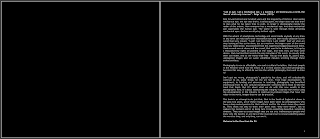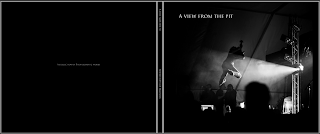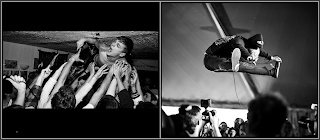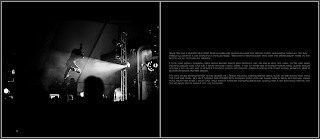My
final book is a far cry from my first idea, I began this project
wanting to create a book based around car fanatics and their pride and
joy; their cars. I wanted to base my book on something that I knew
nothing about. I thought it would be an interesting exercise to find out
more about something that other people held a lot of passion for, where
I felt none. This book was going to be called ‘60 seconds of passion’
and would contain a 60 second transcribed interview with each subject
followed by a series of portrait/editorial type images. Oh how I am glad
that I changed my idea, I quickly realised that 12 weeks is not a long
time at all, especially when you consider that I also needed 2 weeks for
delivery of the book (if I used an online book creator) and what if the
first draft wasn’t right and I had to send it off to get reprinted,
thats 4 weeks gone already. I had given myself a lot of work to do in
this small time frame, I then decided that maybe creating a book about
something that I already hold a passion for myself, would make life a
lot more easier and I could therefore put more of myself into it.
My
idea started to form in my mind over the next week, over the past few
years I have based my Photographic career within the Music scene and I
have noticed a change occurring. With the age of Digital Photography
there seems to be more and more ‘Photographers’ at live shows every
week, with the invention of longer lenses and more powerful flashes you
no longer need to be in the photo pit at the front to get decent images
of the bands. What I find frustrating is the next day the internet is
awash with imagery and it is hard for Photographers who rely on their
photos to pay their rent to get their images noticed. I observe more
people every night taking photos on their phone and standing in a
crowded venue uploading the said image to facebook, instagram or twitter
within seconds of taking said image. I witness these people missing
bands on the stage pouring their hearts into every second of the
performance, just so they can get a badly lit, poorly composed image
online to say “hey, look where I am!”. Do they realise that they could
experience the show for themselves, right there and then and still go
online the next day and see images created by photographers who are paid
to be there.
I
therefore wanted to base my book on this idea of Music Photography and
the battle against ‘iPhoneography’. I wanted to show that Music
Photography is something that some of us pour our hearts into rather
than just pointing a phone over the crowds head and hoping for the best,
then missing two songs whilst you show your online friends. I thought
that just using my own images wouldn’t be the best way t go about this,
mainly because I wanted a lot of variety in the images and I also wanted
to reach a wider audience, maybe a collection of photographers and
their images would be the way to go. Each Photographer would need to
have a distinctive style to make the book work so I started to look for
potential people to collaborate with on this project. The beauty of this
idea is that it combines everything that I had thought about so far in
the build up of this project; photography, people and their passions and
Music Photography.
I
sent an email out to prospective Photographers, probably about ten in
all and I received replies from all of them; only three however said
that they would have time to contribute in the small time frame that I
had. I was happy with this, myself included that gave me four
Photographers to contribute. I also asked one of the Photographers if
they would write a small introduction for the book. I thought that this
would add to the book as she is an editor on an up and coming London
based music magazine called ‘Discovered’. This I thought would help with
getting the book out there to the public. Unfortunately when it got
closer to the deadline she had no time to supply either images or an
introduction. This was a big blow to the structure of the book and I
decided to get it written myself.
I
eventually had ten images each from three Photographers, myself, Andy
Ford and Greig Clifford. We each work in different areas of the south of
England so as a collective it was quite a nice mix. I started to play
around on Blurb.com with the images to edit them down and create an
order that felt right. I started with Andy’s images as, to be honest,
they were and still are my favourite ones. I believe that he has a great
eye and always captures the moment of a show in a fantastic way. I
whittled his ten images down to seven and placed them in a order and
particular book format that suited the images. I chose 13 x 11 inches as
I felt that this size gave the images the viewing format they deserved,
small pages therefore small images would have been too small for the
subject matter. Once I found a layout and order that suited the images
i did the same for Cliffords and my own images. I felt that the book
needed something else to carry on the concept, I asked each of the guys
to write a short piece about why they love music photography, why they
do it and what their thoughts on the books concept were. This added
another element to the book, it no longer was a portfolio of images, it
now had an idea behind it, it gave the book purpose. I originally had
this text at the beginning of each photographers section, I later chose
to move it to the end, this worked better as a it added a kind of full
stop to the end of the sections.
My
final book arrived in the post and I have to say I was very pleased
with it, the front cover image is subtle enough as to not take over from
the text but attention grabbing enough to draw you in. The title itself
‘A View From the Pit’ was my second choice but I find works very well
with the concept. The flow of the pages works well, it starts with a
contents page and then you are faced with the introduction which i think
outlines the concept in a short but punchy way intriguing the viewer to
turn the pages. The quality and finish of the paper is very nice, I
went for the more expensive heavy weight/matte finish. This was so it
didn’t feel cheap in the readers hands and it also reduces shine off the
pages so the images can be viewed from most angles. The only thing I
would change about my book at this point would be to add more
Photographers, it feels as though the book should be thicker and once
you have got to the end you feel as though their should be more to come.
maybe this is something that I can continue with after the module has
finished. All in all I am proud of my book and it has encouraged me to
do more with my images after the shutter has clicked. Photography has
come a long way in the past ten years and we only seem to view images on
a screen now, this module has spurred me on to change this with my own
work.










